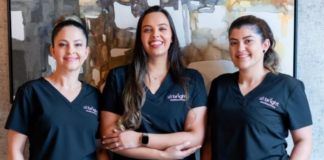 As a young woman in my early 20s, I began to think about birth. Long before becoming a mother was even something I was entertaining, I watched the documentary The Business of Being Born by Ricki Lake and, much later, the film Babies, which chronicles the first year of life of babies from several different cultures around the world. When the time came for me to be pregnant and deliver my children, I felt certain that I would do so “naturally,” probably in a bathtub with monks chanting in the background. My mother had three unmedicated midwife births; why shouldn’t that happen for me?
As a young woman in my early 20s, I began to think about birth. Long before becoming a mother was even something I was entertaining, I watched the documentary The Business of Being Born by Ricki Lake and, much later, the film Babies, which chronicles the first year of life of babies from several different cultures around the world. When the time came for me to be pregnant and deliver my children, I felt certain that I would do so “naturally,” probably in a bathtub with monks chanting in the background. My mother had three unmedicated midwife births; why shouldn’t that happen for me?
Sadly, my first pregnancy ended in miscarriage, and I went through a range of complicated emotions as many women do during that period after a loss. Was it something I did? Could I get pregnant again? Luckily I did in 2010, and during that pregnancy, I tried to take good care of myself; prenatal yoga, vitamins, eating right, etc. We did a birth class at the hospital as well as a breastfeeding class.
Unfortunately, a midwife birth at home wasn’t in the cards for me due to a couple of preexisting conditions that made me “high risk” and required me to move to a high-risk OBGYN group. When I was over 30 weeks pregnant, the doctors noticed that my daughter was breech. In the weeks that followed, I went to a chiropractor and did every exercise I could find on spinning babies. I also tried an external cephalic version where they tried to turn her around from the outside.
Nothing worked. To my great disappointment, I had to have a scheduled c-section, and on November 2, 2010 my daughter was born. A healthy baby and a healthy mom are the most important outcome, right? Absolutely. I could get into the fact that breech deliveries could happen safely vaginally if practitioners were trained properly (and still do in many parts of the world), but that’s a separate issue.
For my second delivery with my son in 2013, I was ready for that VBAC (vaginal birth after c-section). I found a wonderful doula and attended a fantastic Hypnobirth class. I was determined to have that natural vaginal delivery! I ended up with the same high-risk practice after being discouraged from trying for a VBAC by a group of obstetricians in my area. The high-risk group supported my TOLAC (Trial of labor after c-section), and I was ready!
Wouldn’t you know that baby was breech too!? Just as before, I tried everything to turn him, including moxibustion and acupuncture along with another ECV. But that guy had other plans, and on January 28, 2013 my son was also born via scheduled c-section.
Fast forward to 2018 and surprise baby #3. Early in this pregnancy, I brought up the idea of trying for a vaginal delivery, and again the conventional OBGYN office said that it was absolutely not a possibility. The high-risk group shared concerns and some scary statistics but did not say they would not support it. I assumed that since both of my other babies ended up being breech, this one would be too. However, she surprised us all and was in a great position for the end of the pregnancy.
Now to the statistics: The concern with a vaginal delivery after a c-section is mainly uterine rupture. If this happens, the risk is most immediately to the baby, who can lose oxygen and even die. A scary outcome! The risk for the mother is emergency surgery and even a hysterectomy if the damage is too severe. With one uterine scar, the risk is about .8%, and with two, it’s about 1.8%. These odds are still extremely low, although if you are the one it happens to, the statistics don’t really matter, and the outcome can be devastating. On the other hand, a c-section is major surgery and certainly not without risks. The potential for blood loss, the longer recovery time, and the need for major narcotic medication are all real factors to consider.
My doctors were on board with a TOLAC but highly encouraged me to go in for an induction, if not a c-section, at 39 weeks based on my other health concerns. I found out that the two doctors who were “on” at the hospital at that time were supportive of the plan. After many discussions with my husband and other family members, I decided to try to have a vaginal delivery.
Since I had not gone into labor naturally by 39 weeks and 2 days, they brought me in for an induction. As the residents started the induction (they inserted a foley catheter balloon to dilate my cervix), the attending doctor at the hospital announced that I had only a 30% chance of success when they plugged my age, weight, and ethnicity into their formula. I loved it when the resident said, “Well, there are a lot of ways to interpret those numbers.” Exactly. And also, telling a woman with her legs in the stirrups already undergoing this procedure that there is a low chance for success isn’t the best timing. Or, as my husband jokingly said after in a nod to Star Wars, “Never tell me the odds!”
The next morning the foley catheter came out, and I was contracting on my own and dilated to 2cm. By the afternoon, the doctors wanted to start Pitocin. They did so very slowly, eventually having me on a full dose by the end of the day. I got a shot of morphine to help me sleep a bit that night, and around noon on the next day, the doctor suggested that they break my water as I hadn’t dilated past 4cm.
After that, things became more intense, and I requested an epidural. Unfortunately, I didn’t experience the immediate relief of the epidural. It never fully eliminated the pain and eventually moved in my spine during transition when I had contractions every minute. It was incredibly intense. It took an hour for the anesthesiologist to get to me, at which point I became the crazy lady in the movies screaming about not being able to do it and give me all the drugs.
In that hour, I dilated from 4 to 9cm and was fully effaced. I rested a bit after adjusting the epidural, and then they asked me if I felt the urge to push. I stated that I did not and rested a bit more. The resident doctor informed me that I should be prepared to push for 2-4 hours for my first vaginal delivery. In my mind, I was thinking, “Oh, hell no, I did not go through this whole induction for over 50 hours to push for 4 hours.” I informed them that I would like to do some “practice pushes,” but in my mind, I was thinking, “I’m getting this baby out right now.” I pushed for 10 minutes with all my might, and she was out! She was a 5lb 13oz perfect peanut.
Looking back, I think fear was a real factor in my delivery. Knowing that uterine rupture was possible, and when my contractions were so intense, I was afraid that something was wrong (having nothing to compare it to). Although I felt fully supported in my decision to try for a vaginal delivery, I also feel like doctors really drive home the fear factor. I wonder how I would have felt less fear that I was in imminent danger of uterine rupture.
I’m often asked if I’m glad that I finally had a vaginal delivery and whether I feel that the faster recovery was “worth it.” It’s a tough question to answer as I’m only still 11 weeks postpartum. Ideally, I wouldn’t have been induced; I would have gone into labor naturally and not needed any drugs. However, if I’ve learned anything about pregnancy, birth, and parenting in my eight-year journey thus far, it would be that nothing is ideal and that we are all just doing our best to make the best decisions given the information that we have at the time.
VBAC is statistically a very safe option and one that will hopefully be supported by more providers in due time. Even after two c-sections, the risk of complication is low. However, it is a very personal decision and one to be made carefully with your partner and providers. Ultimately, it was the right decision for me. I still can’t believe that I was able to bring this new little girl into the world!


























Thank you for sharing your story as I am currently battling the same decisions. Can you please share the doctors that you used that were supportive of a Vbac?
Hi! I delivered with maternal fetal medicine at Yale. I’m happy to discuss further if you would like to email me. [email protected]